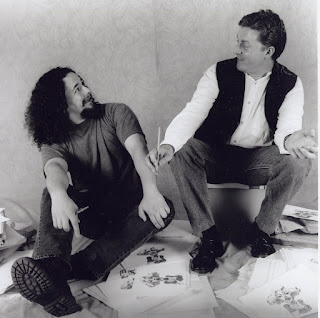Hi All,
This time I confess the post is nothing to do with the making of my short film being created in Anime Studio Pro. However, I thought you may find it of interest. In 1997 a friend, Victor Georgiev, and I created an animated film for Central TV as part of their 'First Cut' scheme. It was made entirely on Amiga A1200 computers. At the time I kept a sort of diary on the making of the film and wrote it up as an AmigaGuide for Amiga users. Recently I found the disc with this on and I managed to get it onto my PC, which was a bit tricky so I apologise if there are any mistakes and continuity is a bit out. The AmigaGuide was a hypertext document and didn't run linearly.
I warn you, it's rather long but it does give an insight into the making of the film and what we learned along the way.
Anyway, here it is.....
Making Of All TalkIn no way could I describe our 5 minute animated film 'All Talk' as a major landmark in the history of movie making. However, it was made using the machine that we all cherish so I thought other Amiga users may find some background information on the making of our (very) minor epic useful.
This guide takes the form of a sort of diary, though I didn't think it necessary to go into as much detail as giving dates and times.
How did it all startI have been creating animations ( some really awful ones! ) since I was about 10 years old using Super 8 film. Later I used the 16mm format and created a couple of short films, animation for BBC's 'Hartbeat', the titles to BBC's MovieGame and a few other bits and bobs. It was about 5 years ago when I first learned of the Amiga computer and my working methods were to change drastically.
I was working freelance as an animator at the time and was employed at the studio of a good friend of mine, Gavin Prime. Although mostly involved in the production of stop motion animation using puppets, Gavin did produce the odd cel animation from time to time. He had heard that the Amiga was being used as a very efficient 'line tester' with a piece of software called 'Take 2' and a little box that connected a video camera to the computer called a digitiser. All this could be purchased very reasonably. As professional line test systems at that time cost in
the region of £20,000 or so the Amiga seemed an absolute bargain!
Gavin purchased an Amiga A1200, a Rombo digitiser and Take 2. Most of my lunch breaks were spent reading through the Take 2 manual, the A1200 guide and any Amiga magazines I could get hold of.
The A1200 proved invaluable, not only for line testing drawn animation but also as a reliable 'video assist' system with the Amiga connected to a video camera mounted next to the film camera. Great! We could now animate the puppets and see exactly how the animation was progressing immediately!
It wasn't long before I realised that there was more to the Amiga than just a line test / video assist unit. As I read the magazines and learned more about the computer I became very excited at the prospect of being able to create animation, colour it and view it straight away. I soon had my own A1200 Desktop Dynamite Pack and was hooked.
Although I don't think anything looks as good as an image created on film, the advantages of being able to create animation and store it in the computer before downloading to video are many. No negative costs, processing, cutting print, release print, neg cutting, etc etc...
Anyway, the differences between film and video aren't so noticeable with animation.
Victor Georgiev arrived in England from Bulgaria in 1995 to try and further his animation career and began work at Gavin Primes. Victor became a total Amiga addict too when he saw some puppet animation digitised into the machine. A couple of weeks later he bought one! Not long afterwards he succeeded in making me really jealous by fitting his machine with a Blizzard 060 accelerator card. We began putting some ideas together for animated films that we could create using the Amiga.
A BeginningIn May 1997 I recieved an information pack from the Central England Screen Commission notifying me of the 1997 First Cut Scheme. First Cut, a scheme financed and run by the Screen Commission, West Midlands Arts, Central TV and a few others, had been in operation for a few years. It enables new directors to make a short film with a guaranteed broadcast slot in the Midlands via Central.
Victor Georgiev and I put together three idea's and submitted them with a showreel of Amiga and film animations. The first idea was a sort of animated talk show. The second was 'Mad Frogs From Outer Space', a strange homage to the monster B Movies of the 50's and the third, the one we most wanted to do, was called 'Krai'. I even went as far as creating a full animatic on the Amiga for 'Krai' in the hope of persuading the commissioning board to choose this film!
In early June we were asked to go to a meeting at Central TV where we had to 'pitch' our idea's and try and convince them that we could produce an original and high quality film in the time given. The film had to be delivered by the end of September.
There were seven films being commissioned in all but ours was the only one containing animation. Victor and I had attended a couple of these meetings before and, as in previous times, didn't really expect the projects to be taken any further.
Before I even arrived home from the meeting Lindsey, my wife, had taken a telephone call informing that we had been granted the commission and could begin work on our film immediately. There was one stipulation however, they liked all three idea's and wanted us to link them in some way. The film had to last EXACTLY 5 minutes! If it was any longer there was a chance that commercials would cut it off!!
We had to come up with a new script fast to link the idea's together in a convincing way.
As three scripts were first submitted to the Screen Commission, 'All Talk', 'Krai' and 'Mad Frogs From Outer Space', it seemed a formidable task to try and link the three in some way so that they didn't appear to be three completely seperate films. I was getting a little nervous now as here we were without a final script. All the other films were 'Live Action' and they would, presumably, all be starting to shoot their productions. With our film we had to draw the whole thing, and we didn't even know exactly mwhat our story was!
Eventually I hit upon the idea of changing the talk show script 'All Talk' so that the subject of the talk show was how the public were influenced by films and TV. This way the other two idea's 'Krai' and 'Mad Frogs' could be shown as examples of films that were a bad influence. Victor agreed that, though it would be tight getting it all into 5 minutes, it worked. So,we set about rewriting the script.
The SoundtrackThe music track for All Talk was being composed by David Stowell. David is a professional musician, composer and orchestra conductor and has composed music for feature films and BBC radio. He showed interest in composing music for our film after seeing the script. He took notes on the music style we wanted as well as rough timings. However, he couldn't record the final piece until he had a copy of the finished visuals to time his music to.
VoicesThe main concern with soundtracks for animated films is finding actors that are capable of creating voices to suit the characters that you have imagined in your head. It may be that the actors interpretation of a character when reading the script is completely different to how you imagined it yourself.
We decided to use just two actors for the voices - one to perform all the female and one all the male. For the male voices I already had Ian Fairbairn in mind. Ian has done work for me before on other projects so I know the amazing range of voices he has. Once a very busy character actor Ian is now semi retired. He has appeared in Dr.Who, The Avengers, The Professionals, Timeslip etc. Does anybody else remember Timeslip?
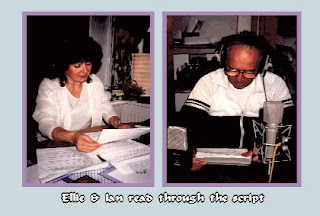
For the female voices we decided upon Josie Lawrence. I managed to find out who her agents were through the Screen Commission and faxed a copy of the script. I recieved a reply saying Josie thought it was great and would love to do it but was busy with other projects for two weeks. As we really had to get the voice track done right away we couldn't afford to wait the two weeks and had to find someone else.
Ellie Darvill was recommended to us. I immediately called her and she demonstrated several American accents and lots of different characters over the phone. Brilliant! Ellie has appeared in Brookside as well as playing various characters on radio. Maybe her greatest claim to fame is as the voice of the WHY bird on BBC's Playdays. Luckily Ellies husband, Nigel, is a musician (keyboards with Fine Young Cannibals ) and had his own recording studio so we could record the voice track there. I arranged for Ian Fairbairn to come up to Bournville in Birmingham from London and we all met at the Darvill recording studio.
While Nigel set up the equipment Ian and Ellie rehearsed the script over a cup of coffee and performed it brilliantly. I remember hoping they would be able to do it as well when it was being recorded.
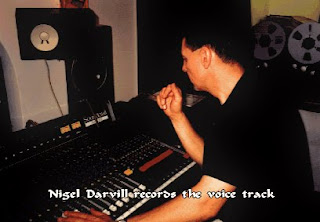
The DAT recorder started running and Victor and I followed the script as Ian and Ellie performed the characters in the sound booth next door. It was done just like a radio play in one take and without any mistakes at all! Nigel just cut it together a little tighter by shortening gaps between lines here and there. Atlast we had our soundtrack and could now get down to animating. Well, almost. First we had to take the DAT track to Waterside Sound Studios in the centre of Birmingham to be transferred to 16mm magnetic film.

16mm magnetic film is exactly the same as 16mm film except that it is totally covered in magnetic oxide like normal recording tape. It even has the sprocket holes ( one per frame ) down the side. This means that, when recorded, 16mm mag can be run over a soundhead and the sound on each frame actually marked on the surface of the tape. These markings are simply transferred to the Exposure Sheets and the animator now knows exactly how many frames a sound covers and what sound is on what frame.
Unfortunately, when we listened to the actors recording of the soundtrack we found that it was much too long. Nearly twice as long as it should have been infact! I had roughly timed myself reading through the script but the actors had obviously performed it at a much slower pace. This meant more time taken up as I spent days editing the soundtrack to last 5 minutes exactly. Worse still, it meant that some of my favourite lines of dialogue had to be cut just so we could keep the flow of the story.
Now we had the soundtrack we could start on the Storyboards.
The StoryboardThe storyboard was drawn very roughly as we HAD to get the animation done and there wasn't time to spend days drawing finely detailed images. As long as we could see all the shots and check that the continuity was okay then that was fine. We used A4 paper divided into 6 for storyboards and pinned these to the noteboard, in the small room I use as a studio, for reference.
Because of all the dialogue in All Talk it was far more important to spend time getting the Exposure Sheets filled in correctly than have beautiful storyboards.
AnimationOnce we had the storyboard completed I began animating using the exposure sheets as a guide for the dialogue. Victor had already started animating the Krai section whilst I was reading the track and filling out the exposure sheets.
I had animated the title sequence for the 'Mad Frogs' section of the film and, with the help of Lindsey, shot all the live action footage of me 'acting' ready to be placed over drawn backgrounds and composited with animation. I like this technique of mixing live action and animation and used it before in a Low Res PD animation of me being eaten by a giant bee called 'The Adventures Of Eddie'.
The first shot I animated from the talk show section was the close up of Kristel where she first speaks and says "Good evening, the question we ask tonight is....". I decided to animate this shot
to reasure myself that the Amiga was going to be able to play back the animation at the required speed to keep in synch with the track. I handed the rough animation to Victor for him to 'clean up' in black pencil while I sampled the whole All Talk track, a line at a time, into the Amiga using TechnoSound Turbo II.
Nick Veitch and Vicki from Amiga Format were at my house to interview Victor and me about the film for the magazine, and see the Amiga Set Up we were using,when Victor arrived with a digitised version of the first shot on a floppy disk. Everyone watched as I loaded the anim from the floppy into AnimatED and loaded the sample to come in on the first frame kristels mouth moved. I set the frame rate and prayed before hitting Play. It was a great relief when Kristel moved and spoke in perfect synch! It's moments like this when all the hard work seems worthwhile. Although only a black and white test, this character was moving and talking.
Ofcourse, this didn't mean that the colour animation would run in synch but I needn't have worried as a couple of days later Victor had finished colouring the shot and it synched up just fine. I tried to keep the colour palette of the animation down to 32 and converted all the 24 bit scans to 32 colours which worked okay, with care.

The next part of the process was to place Kristel over a background of the TV audience. Victor had drawn 4 seperate images of the background so that we could 'boil' them if needed. The animation, being in that aforementioned sketchy style, resulted in the image 'wobbling' from frame to frame and we thought it a good idea to have the background move in a similar way. Not everyone likes the shimmering or 'Roobarb effect' as it has come to be known by those of us old enough to remember the adventures of the green dog. However, for a short film like ours it can be quite effective. Besides, we were under pressure to make the film as original in style as we could and we both wanted to make the film appear as far away from what is normally thought of as computer animation as possible. It's doubtful many people would realise a computer had been used in production at all. I did do a test with a static background but, to us anyway, it just didn't look right. It would have saved us a LOT of time if we'd had a single static background because Brilliance would have saved the BG to all the animation in one go. As it was I had to load in the first BG pic and merge it, on every 4th frame of the animation, behind the foreground image. I then had to load in the second BG pic and merge this, starting from frame 2, on every 4th frame and so on!!
By the way, as I appeared in the 'Mad Frogs' section, as the Live Action character, Victor decided that he would appear in the film too and placed a caricature of himself in the audience. On the opening shot he is on the right hand side - the character with long hair and a beard! Nick Veitch is also in the audience somewhere but I can't remember on which shot now.
It soon became apparent that just under three months really wasn't long enough for us to complete the film in the style we had chosen to create it in. We ran into several problems and found that as the deadline drew closer we were nowhere near finishing. I have never worked so hard in my life and both Victor and I found ourselves having to work several days and nights none stop to try and finish the thing.
ProblemsWhere to start! One problem we hadn't accounted for was the length of time it takes a picture to scan. Four minutes doesn't sound a great deal of time to scan a colour drawing but when there are 100 drawings to scan that's a long time! If we had done the film in the style I normally adopt of just creating outline drawings on paper and scanning these for colouring in Brilliance or DPaint then we would have had no trouble. Black and white images scan really fast but these colour images had to be scanned at 24 bit which took ages!
Having to add four background images to every shot just to give the whole scene a 'shimmer' also slowed us down greatly. We must have been crazy to adopt this style!
In addition, apart from these production problems brought on by our own initial decisions about the style of the film, other things beyond our control seemed intent on slowing us down....
Victors car packed in and I had to travel to Victors ( about a 50 minute round trip ) every two days to deliver and collect drawings. One of our two dogs mysteriously became seriously ill and died of poisoning. Obviously, Lindsey was distraught and I wasn't feeling over the moon myself by this time. The following weekend my Great Uncle was taken ill and died three days later! I was beginning to wonder if we were ever going to finish the film.
All we could do was get as much done as possible and hopefully make a film out of the footage that we had. There was no way we could get the deadline extended as things had been booked in advance and the broadcast date was already set! We were absolutely drained when time came to do the editing.
EditingWe didn't have all the shots completed but the editing time had been booked and we HAD to be there! Besides, Jim Tetlow had been booked to dubb the soundtrack the following day so we had no choice! Part of 'the Lady and her husband in the audience shot' needed the background adding and the 'Mad Frogs' section wasn't compiled at all!
Before the film could be edited I had to get all of the animation off the Amiga and onto videotape somehow. I took the Amiga and all my Zip cartridges containing the animation to Media Forge in Wolverhampton. Mike Turner connected the Amiga, via the composite output, to a Beta SP broadcast video machine. We did try connecting using a genlock and the video/monitor port of the Amiga but we got better results without. The animation was downloaded a shot at a time by simply double clicking on the MainActor anim icons. The sampled soundtrack was also recorded
as a guide for sound dubbing later.
Armed with the Beta SP tape with all the bits on I raced over to meet Victor at BBC Pebble Mill where the editing was to take place. Jonathan Birkett was waiting for us as we walked into the video editing suite. Firstly we needed a title sequence made up using the stills that Victor had drawn. Jonathan took the stills from our master video and manipulated them in an effects generator to create a nice typical talk show title sequence. It was only when I looked at the video later that I noticed that the stills appear transparent in places which is a shame.
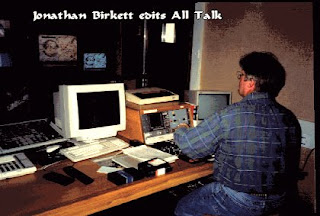
We edited the film together but it became evident that without the missing shots we weren't going to have much of a film! Jonathan very kindly stated that if we left blank spaces in the video where the shots should be, we could drop the shots into place the next morning. This meant finishing the missing shots overnight and returning to Pebble Mill early the next day! We did a VHS copy, with 'timecode', of the film so far so that David Stowell could work out the timings of his music before recording it to DAT tape.
Victor came home with me and did some drawings for 'Mad Frogs' while I added backgrounds to the 'Lady In Audience' shots. David Stowell arrived at 7 oclock to pick up the VHS copy and was to deliver the DAT tape to me at the BBC the next morning. At 8 0clock David telephoned to say there was no timecode on the VHS tape after all!! We decided that he would still come to Pebble Mill in the morning, pick up a new VHS, go home and readjust his music to the timings then deliver the DAT directly to Jim Tetlow for dubbing to the film!
Victor had to go about midnight so I carried on compiling the animations. Because each frame of the animation was very different to the previous one they would take ages to save so I took the opportunity to have a rest on the floor while this was taking place.
I finished the 'Mad Frogs' section ( nothing like the version scripted but atleast I'd done something! ) at 8.30 in the morning and shoved the Amiga and zip cartridges into a bag and raced down the M6 to be at Pebble Mill for 9 oclock! Jonathan connected the Amiga to a Beta machine and we downloaded the new shots before dropping them into the blank spaces on the video. David Stowell was waiting in the foyer and a VHS timecoded copy was handed to him as I went past on my way to Jim Tetlows, in Kings Heath Birmingham, for the sound dubbing.
Sound DubbingThe whole of the upper floor of Jim Tetlows home is a sound studio. Jim is responsible for dubbing the sound on all of the 'Spitting Image' series so is very experienced at creating a soundtrack for films where no sound could be recorded live...like animation.
He loaded the Beta video and the original DAT voice track and began dropping in the bits of the voice track from the DAT tape to replace the rough sound samples that existed on the film at the moment. It was amazing to watch him cutting the track on his computer system.
I think I may have fallen asleep at some point because I remember Jim telling me I should get home and he would carry on with the dubbing. I left after telling him that David Stowell would be over at some point with the music track.
To make matters worse, when I arrived home I found that our telephone was out of order so I couldn't call Victor and let him know how the day had gone. I rested and then later walked to a phone box to call David to find out if he had delivered the music okay. He had. I called Victor then went home to bed.
A few days later Victor and I visited the screen commission to sign some paperwork, expecting to be chastised severely for delivering the film late. Instead we were greeted by Pat Roberts who said that Victor and I were hero's! Apparently Central loved the film and even Michael forte, head of Childrens TV there had been called in to view it. Victor and I were taken into a room to see the finished item. I must admit I had been feeling a bit despondent after all the hassles and problems but Jim Tetlow had done a brilliant job with the sound. The film didn't look too bad at all. Okay, so it wasn't exactly the film we had hoped it would be but we finished it,just about, and
Central and The Screen Commission liked it!
Maybe the Premiere Night that Central had organised to show all the films commissioned wouldn't be so bad after all.
Premiere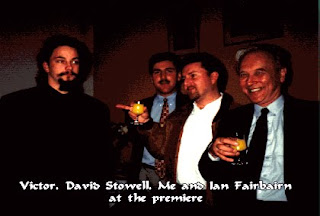
Central had organised a Premiere Night to take place in a Media Complex in Nottingham. All of the commissioned films were to be shown. Everyone involved in our film wanted to be there. Ian
was coming from London, Ellie and Nigel Darvill, David Stowell, Jim Tetlow and Victors Mother and my Wife Lindsey. There was a large buffet before the screenings which calmed our nerves a
little.
Soon we were all in the cinema in an apprehensive state. Someone from Central TV introduced the screening and talked about all the films. I was pleased that they even mentioned the Amiga had been used in the making of the animated film.
However, I wasn't so pleased when the first film came on screen! It seemed obvious to me that the video projector hadn't been set up correctly. The whites were VERY washed out, infact all of the colours looked strange. When our film came on, because the drawing was on white paper, it looked even more washed out than the other films! Victor and I couldn't believe it!! I have a friend who has a cinema at home and uses a video projector to show laser discs and the image is stunning so I knew this wasn't right.
I found out afterwards that the video projector had arrived late and not been checked! The disappointment was huge as this was the first time that many people involved in the production had seen the film.
Luckily, another evening was organised in Birmingham to screen the films to the press. This time the projection was superb and everthing went well, I'm relieved to say. Many people came up to us and said the film was impressive and had we really done it on the Amiga? I took great pleasure in explaining that we had indeed.
Even with all the problems we had encountered I wouldn't have missed the experience. The summer had gone - I had been in our back garden twice in the whole of it - and I had hardly seen any sun at all. Lindsey had been amazingly patient and understanding. We had fully intended going away for a week during the summer and she had even booked her leave but it was obvious we wouldn't have finished the film and she cancelled it. She booked it again for a later date believing that we MUST have finished by then! We hadn't. She took her leave anyway and stayed at home. I think I have some making up to do!!
'All Talk' was broadcast on 30th October 1997, shown at the Birmingham Film and Television Festival.
ThanksThere are many people that gave a lot of help and advice during the making of All Talk. I just wanted to put it in writing here that their assistance was greatly appreciated....
Pat Roberts, Mike Richardson, Jasmin Quansah and all at the Central England Screen Commission for believing in us in the first place.
Central Television, especially Karen Davies, for giving us the opportunity of getting our film made and seen.
Ian, Ellie and Nigel for doing a brilliant job with the soundtrack.
David Stowell for composing some excellent music in such a short space of time and under tremendous pressure. Sorry Dave!
Jim Tetlow for working wonders with the track and really bringing the film to life.
Marco Vigelius and Markus Moenig, not only for their superb animation software, without which we probably couldn't have made the film, but also for quickly answering any questions and offering an enormous amount of help.
Nick Veitch, Ben Vost and all at Amiga Format for their help, advice and genuine enthusiasm for the AMIGA.
I would also like to thank the AMIGA community for comments, interest and encouragement and All those companies that still support the AMIGA.
Last but definitely not least I must thank my wife,Lindsey, who had to put up with a fantastic amount. I sat at the light box or computer for the whole summer! Lindsey changed her holiday leave twice and we still never got a holiday!








































